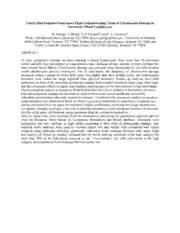
NASA Technical Reports Server (NTRS) 20110006998: Cancer Risk Estimates from Space Flight Estimated Using Yields of Chromosome Damage in Astronaut's Blood Lymphocytes PDF
Preview NASA Technical Reports Server (NTRS) 20110006998: Cancer Risk Estimates from Space Flight Estimated Using Yields of Chromosome Damage in Astronaut's Blood Lymphocytes
Cancer Risk Estimates from Space Flight Estimated using Yields of Chromosome Damage in Astronaut’s Blood Lymphocytes K. George,1 J. Rhone,2 L.J. Chappell3 and F. A. Cucinotta4 1Wyle, 1290 Hercules Drive, Houston, TX 77058, [email protected], 2University of Houston, 4800 Calhoun Road, Houston, TX 77004, 3USRA, Division of Life Sciences, Houston TX 77058 and 3NASA, Lyndon B. Johnson Space Center, 2101 NASA Parkway, Houston TX 77058. ABSTRACT To date, cytogenetic damage has been assessed in blood lymphocytes from more than 30 astronauts before and after they participated in long-duration space missions of three months or more on board the International Space Station. Chromosome damage was assessed using fluorescence in situ hybridization whole chromosome analysis techniques. For all individuals, the frequency of chromosome damage measured within a month of return from space was higher than their prefight yield, and biodosimetry estimates were within the range expected from physical dosimetry. Follow up analyses have been performed on most of the astronauts at intervals ranging from around 6 months to many years after flight, and the cytogenetic effects of repeat long-duration missions have so far been assessed in four individuals. Chromosomal aberrations in peripheral blood lymphocytes have been validated as biomarkers of cancer risk and cytogenetic damage can therefore be used to characterize excess health risk incurred by individual crewmembers after their respective missions. Traditional risk assessment models are based on epidemiological data obtained on Earth in cohorts exposed predominantly to acute doses of gamma-rays, and the extrapolation to the space environment is highly problematic, involving very large uncertainties. Cytogenetic damage could play a key role in reducing uncertainty in risk estimation because it is incurred directly in the space environment, using specimens from the astronauts themselves. Relative cancer risks were estimated from the biodosimetry data using the quantitative approach derived from the European Study Group on Cytogenetic Biomarkers and Health database. Astronauts were categorized into low, medium, or high tertiles according to their yield of chromosome damage. Age adjusted tertile rankings were used to estimate cancer risk and results were compared with values obtained using traditional modeling approaches. Individual tertile rankings increased after space flight and analysis of follow up samples indicated that the tertile rankings remained in the high category for more than 50% of the individuals assessed so far. Crewmembers that shift and remain in the high category are projected to have increased life-time cancer risk
